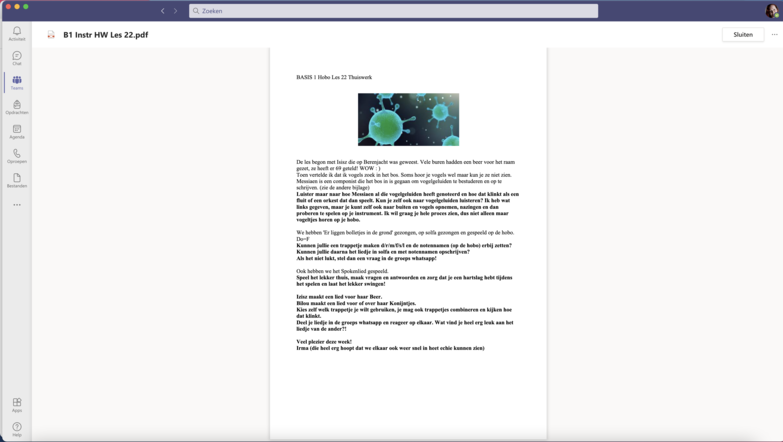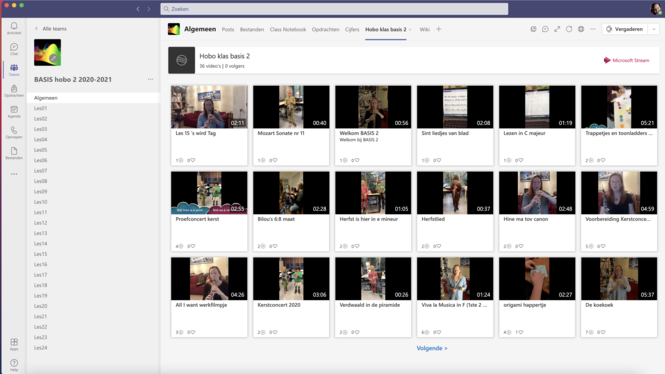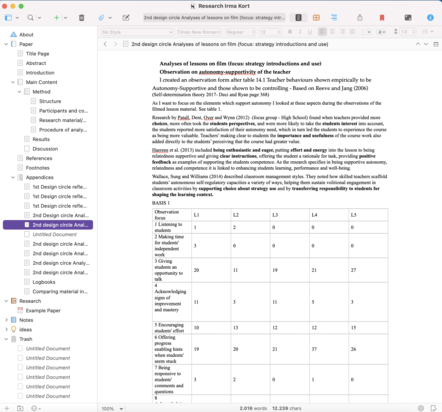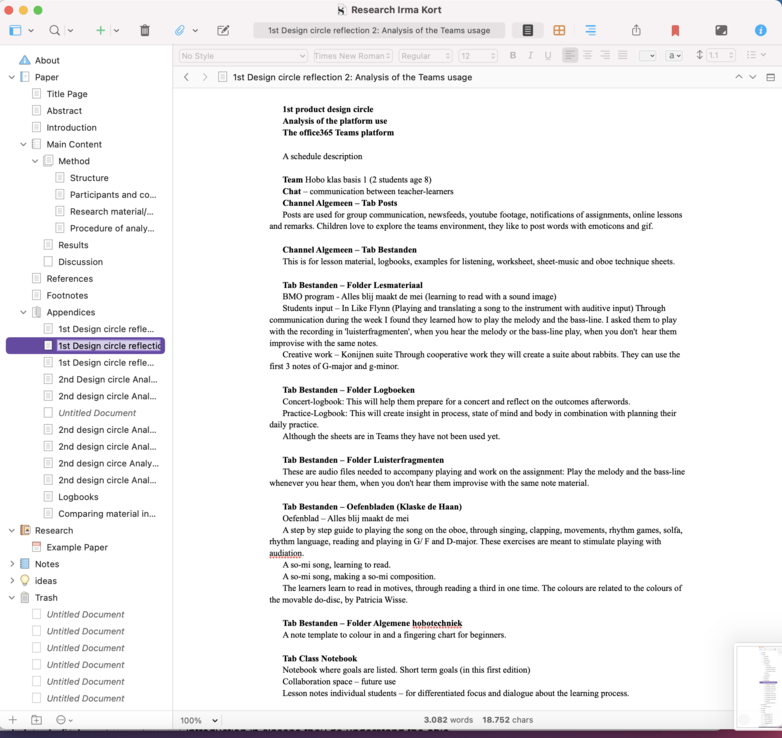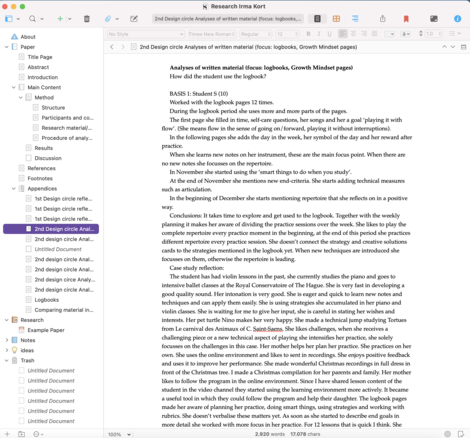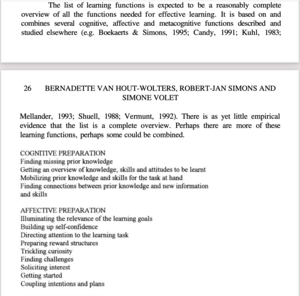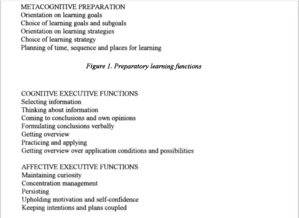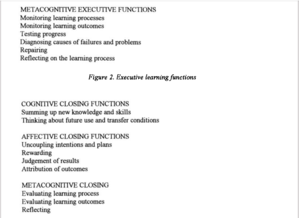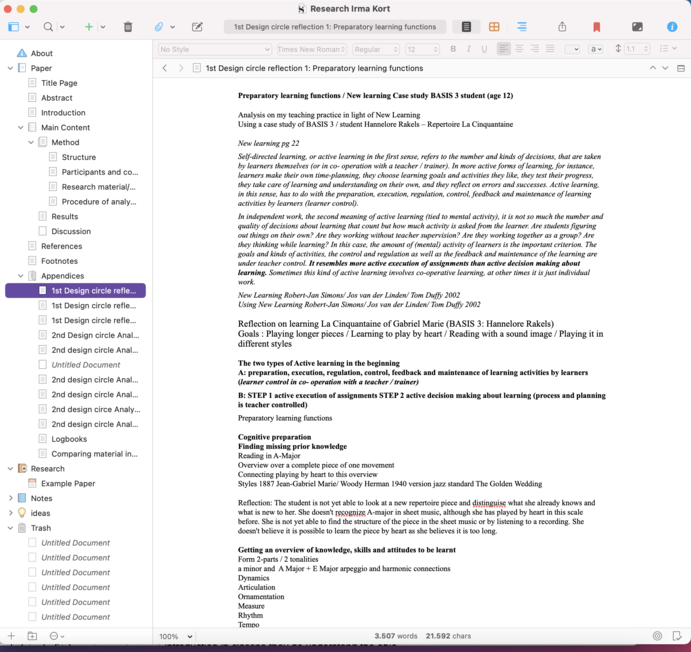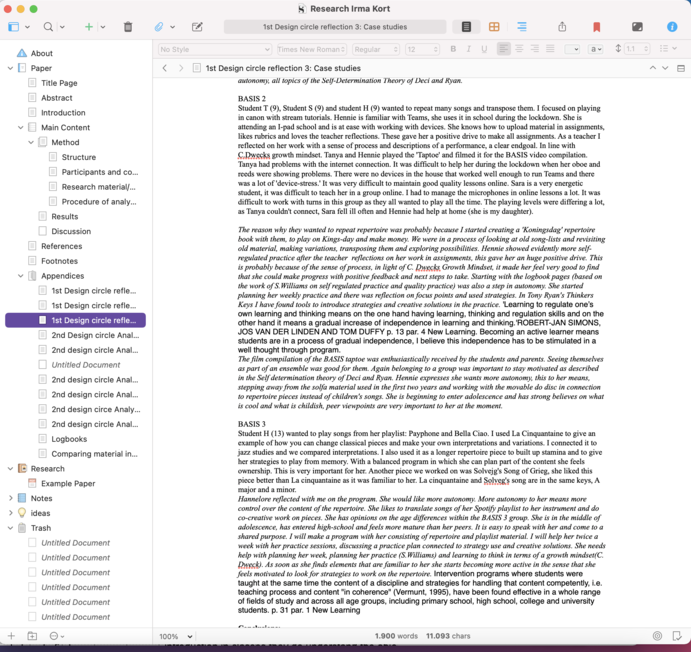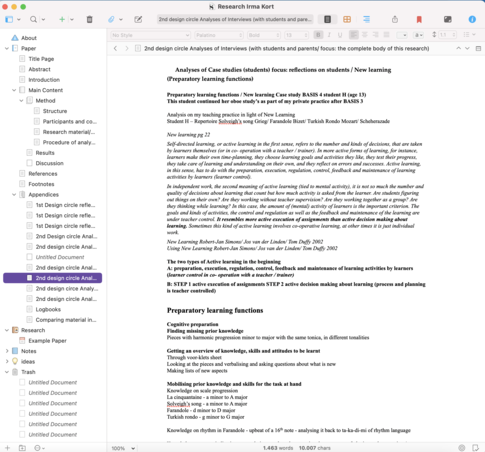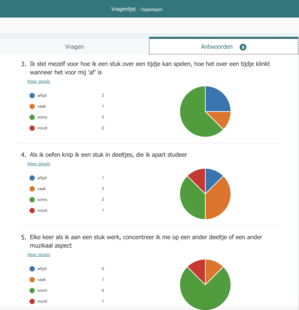Chapter 4. The three design cycles in detail incorporating the action research
This chapter is an overview on the process of the three design cycles and a description of the detailed development of the flipped classroom and the tools, after the case studies, observations and questionnaires. The 1st cycle was a zero measurement and a start to create an inventory on needs in student processes. The 2nd cycle was used to implement and test tools. The 3rd cycle was used to implement changes after observations and reflections. Please follow the hyperlinks.
Cycle one (March 2020-June 2020) Zero measurement.
In the first design cycle I created a version of a blended oboe class. I needed to learn how to work with the program, creating a team, adding applications and tabs. I also had to explore the possibilities of the program.
I developed a logbook, a concert logbook, a personal reflection sheet and a weekly process reflection sheet.
I used the online environment in the lockdown period, to teach. The final lessons of the season were live.
I evaluated with case descriptions on learning functions (observation framework page 26/27 New Learning , a reflection on the online environment (with focus on the content) and case studies of students (with focus on autonomy and active learning).
Cycle two (August 2020-December 2020) Implementing and testing tools.
In the second design cycle I experimented with all options of the online environment. I also made video's introducing the new features and how to find and use them for parents and students.
I started working with the designed tools for stimulating autonomy, self-regulation and active learning.
To promote active learning I changed the homework sheet. It was a repetition of the lesson topics with the songs to practice and some assignments. It became a choice repertoire list, connected to the online learning space with choice of applications and strategy use. Target was to create a situation in which they could learn to use strategies, reflect on the use and get an overview of learning processes, while being able to choose their own repertoire.
To trigger more parental involvement I used more student presence online. I made video footage of the lessons and the students to reflect on the lesson in the online space.
To motivate cooperative learning I used the cooperative space in Teams to develop creative projects. The personal notebooks were used for differentiation when needed.
To have an overview on the lessons and the content I gave every lesson a channel. All the information and material of the lessons could be found in these channels.
The logbooks and Thinkers Keys were introduced in the lessons and through tutorials in stream and the WhatsApp groups. The logbooks were used to learn to focus and reflect on the practice sessions. Every lesson focussed on two or three strategies and creative solutions used in the context of learning a piece.
I have designed a Process planner sheet, a Reflection sheet, an I wish sheet, a Self-image sheet, and a Planning sheet.
The process planner sheet gave insight in the learning functions steps of a process.The Reflection sheet was used to map what a student had learned during the practice week. There was also a sheet with reflective questions. The I wish sheet was designed to think about personal wishes in learning goals and repertoire and to share these. The Self-image sheet gave insight into how students saw themselves and if they could reflect on their qualities and areas where they could grow.
Cycle three (January 2021-April 2021) Further development of tools.
In the third cycle I have connected the wiki tab to assignments. Students will be stimulated to search online and share the information in the wiki tab with their peers.
I have split up the lessons in series. Every series has goals described in the first lesson and steps described in the following lessons. The goals are connected to playlists. At the start of the series YouTube links in posts will be shared to be able to listen to the music. We close the lesson sets with presentations to share with friends and family. To give students prove of the efforts and their effectiveness they receive achievement cards on key-rings, with goals, pieces and creative work on them.
I have made new reflection sheets in three process stages, corresponding with the preparatory, executive and closing learning functions of active learning. Instead of using text I used the Thinkers Keys pictures to reflect on the practice. This will create more overview on their process and they can learn about the differences between musical and technical aspects and cognitive and meta-cognitive learning functions.
The logbooks have been simplified. To make them easier to use and less time consuming. The aspects that were taken out are now in the classroom dialogue and in the online environment when needed.
I have started a dialogue with parents on how to be autonomy supportive in their parenting.
BASIS at The Royal Conservatoire The Hague/ School for Young Talent
for children aged 7 to 12 / a 4 year program / combining theory, instrumental lessons and ensemble classes for woodwinds
7 children were participating in this research
The outcomes of the first design cycle
In the first design cycle I didn't use the channel options in Teams. I did use the posts, files, assignments, stream and wiki. I made group chats to sent and receive messages.
The students and parents needed to get used to the program, the use of posts and files was clear, but it seemed difficult for them to excess the right information easily. Some parents weren't able to open assignments or upload them. The stream channel was used for tutorials but the video's weren't looked at regularly in the practice sessions. They didn't look at the wiki tab and they didn't upload information to share on the pieces and composers. I didn't receive any messages during the week via the chat function. Parents were used to the WhatsApp group for communication. Some students had inadequate internet connections making online lessons difficult during lockdown.
I used Teams to put my lesson content online. The lesson content was teacher driven. I missed chances for developing active and cooperative learning in the online environment and I didn't use students' presence.
In the period of covid-19 measures it was difficult to keep the connection between the parents and the program. They were less involved in the program as they were not allowed to be in the building during lessons and during online lessons they needed to work.
The tools were in the online environment but were not used in this period. I didn't introduce them during lessons yet, as the basic use of the online environment took time in this period.
The third design cycle
I used the reflections of an online usage expert on the online environment of my oboe classes. He advised me to use a general introductions at the beginning of the year and the lesson series. I have numbered the channels in a logical order now. I connected titles of video's in stream, to lesson numbers in channels. Messages in posts are now ordered per subject and links are connected to one message strings, preventing multiple pop-up notifications, which might be perceived as stressfull.
The outcomes of the second design cycle
Using the Teams environment completely, resulted in more exploritive actions by parents and students. With every new aspect in the use I created a video to introduce the new feature. Students and parents could find information easily and started adding links to posts, uploading assignments, using the communication channels and watching the video's in Stream.
Some of the tabs in Teams were used less, like the wiki tab. It would be interesting to connect it to assignments, teaching students how to find information online. Assignments are very stimulating for some students. They enjoy creating video's and uploading them. Motivation increased after receiving the teacher's feedback on the assignments during the week.
Changing the homework sheet into a repertoire playlist resulted in very motivated students, because they could choose what they wanted to work on. When working in groups they often made different choices, playing in class made them want to play pieces of peers. This resulted in practicing more pieces. The overview on processes needs more order. I will shape the lessons in series with lesson goals, connected to the playlists.
Working with strategies and creative solutions was new for the students. To start thinking about a process they needed to be able to describe their goals. They were interested in the Thinkers Keys.
The parents got more involved in the program, watching video's of their children in Stream of lessons and presentations. This resulted in more relatedness around the young musicians. They were praised on their performances and grandparents and extended family could see what they had achieved.
The use of the cooperative space in BASIS 2 was a success. We composed pieces about hamsters, students could look at the work of the other and the compositions were performed in videopresentations. Seeing the work of a peer was inspiring as it functioned as an example of another learning process.
The logbooks and Thinkers Keys were introduced in lessons and online. It was new to the children and they had to get used to the tools.
The sheets for planning, reflection, mindset and self-image were interesting ideas, but weren't used within the online environment. The topics were discussed in the lessons.
Comparing the program over the years
The biggest changes in the program are connected to the focus on 'learning to learn'.
It was a program with musical and technical goals, with many perspectives on the material, such as solfa, rhythm language, audiation, reading, playing and ensemble playing.
Now it also embeds active learning and self-regulating practice. It contains learning cycles where students go through five complete learning cycles every school year. With preparatory, executive and closing learning functions, so they learn to create an overview on their process.They are motivated by many choices in repertoire and strategy use. Through reciprocal dialogue the program is differentiated and partly shaped by the students.
Through reflections in light of the Self-Determination Theory I learned how to be more autonomy supportive in my teaching. It also gave me ideas to focus on relatedness and to built a supportive social bubble in students' musical practice of teacher, family and peers. I explicitly show students their effectiveness and give them many possibilities to work towards presentations, so during the year they can reflect on several practice processes.
To reflect on my own teaching in light of the self-determination theory was interesting, because I used the observation framework of Reeve and Jang (2006). The general question was: When do I see autonomy supportive teaching? Reflecting with a positive framework helped to keep up my motivation and inspire my teaching. I felt positive about my teaching and I was focussed on a teaching aspect I believe is very important. My growth as an educator has increased a lot.
I have seen an increase of motivation, relatedness and competence. Students are getting better in showing their autonomy and they are learning to create an overview on their practice process using learning functions consciously. Their output in practiced pieces and creative work has doubled and they love to sent in recordings to make concertvideo's as presentations. The quality of their end goal descriptions has improved, resulting in more musical playing through external focus, using their breathcontrol in a flexible way in combination with their embouchure. They also use more dynamics, conscious phrasing, visual and auditive images and different articulations.
Creating a blended program changed the set-up of my lessons. It was a great tool to reflect on my teaching style and to check the content of the program. At the start of a process, I determine the lesson goals. I provide students with long lists of repertoire in which they can work on their goals. After choosing pieces I introduce strategies and creative solutions so they can develop their practice plan. Through dialogue live and online, we discover what is needed to take the next steps. The digital learning environment is shaped after the needs of students and where they are in their process. Students can deepen skills and knowledge during the week. I can provide them with challenges, process enabling hints and inspire them when needed. So the online environment is a personal learning space, where everybody shares their input and inspirations and where we all learn together.
Action research: Analyses of logbooks
Some students used the logbooks every practice session in the period between the fall break and the Christmas break. Others used it a few times. The main objection to using the logbook was that it took too much time, there was too much information in it. Students that used it regularly during the experiment kept on using it afterwards, students that showed little interest in the logbooks, still use the tool less. Because of the introduction and reflections on the logbook in classes they do understand the object of the exercise and they do know the purpose of using a logbook. So in spite of little use, it did have an effect on their practice process. An interesting outcome was that as soon as they needed to describe endgoals, because a presentation was coming up, they started to think of a practice plan with strategies and creative solutions. When they didn't describe goals, they just played repertoire for approximately 30 minutes and weren't keen on focussing on musical or performance aspects, nor working with strategies and creative solutions. When there was no need to focus because they could easily play the repertoire this playing without focus was also evident. Students need repertoire they can't finish in one practice session, they need a challenge, to start process thinking. When describing end goals, they started using strategies and the practice sessions had longer duration (up till one hour). So when working with focus on strategies the practice time increased and the practice became focussed. This resulted in better musical performance and the development of an idea of processes.
After working with the logbooks the students were aware of planning, putting planning into action, the existence of strategies and creative solutions and reflection on processes. They also learned about smart things to do while practicing. Such as explaining something to a brother or sister, asking a question, use varied practice and doing the difficult bits first.
The self-image sheet in the context of the music lesson was difficult for them to work on. They didn't have a good overview on what they were good at and what they could improve. The wish list was also hard to answer. They mentioned some songs they heard on the radio and a few technical aspects. These sheets will become part of the teacher - student dialogue.
By using growth mindset sheets the students are developing their ideas about learning. As a teacher, it gave me insight in when they are giving up and why they are giving up, so I could help them sooner in the process and we could talk about it.
Action research outcomes
Case study active learning / learning functions
There was limited active learning. I was planning the process and giving repertoire. The student had some choice in focus on musical and technical goals, practicing the repertoire. There was no overview on process and learning functions in the student. She was waiting for me to show her a path with goals and reflect on it. There was no clear focus on 'learning to learn' in the lessons. I was giving examples of strategies about practice possibilities with a technical or musical focus. I wasn't giving her strategies in the sense of learning functions, that she could apply in different learning processes. We reflected on autonomy in repertoire choice, this was important for her motivation. We discussed what her wishes were and how we could built a program that would motivate her and would include technical and musical goals. There was a motivational increase when we started working on pieces of choice, these included her spotify playlist, known classical repertoire and a playlist I introduced for her to have choice.
Case studies reflections on students' learning processes
During the lockdown period there was more visible autonomy and creativity in the program. The theory and ensemble lessons were not leading and lessons started with students' needs. This resulted in more autonomy and creative work. I could also differentiate better in this period. Time seemed more flexible, as there were no school and hobby schedules. Parents and students found it challenging to find information online and use the Teams environment well. Internet connection and available devices to work with were very important for maintaining the learning process and keeping students motivated to play and study. The possibility to have online lessons was great, students loved to meet during lockdown and were craving contact with friends and teachers. Students presence was important in the online environment. They were enthusiastic about seeing their peers in video's and creative projects. Due to the
covid pandemic I had the chance to reflect on the program in a different perspective, which turned out to have a catalysing effect on the quality of my teaching.
Action research: Analyses of recorded lessons in view of Self-DeterminationTheory
To analyse the lessons in view of the Self-Determination Theory I used the table of Reeve and Jang (2006) 'What teachers say and do to support students' autonomy during a learning activity.'
This table consists of the following observation topics:
1. Listening to students
2. Making time for students' independent work
3. Giving students an opportunity to talk
4. Acknowledging signs of improvement and mastery
5. Encouraging students' effort
6. Offering progress-enabling hints when students seem stuck
7. Being responsive to students' comments and questions
8. Acknowledging students' experiences and perspectives
Three experts observed some of the recorded lessons to see where my observations differed from theirs. The observation focussed on the communication using language in the lessons. The amount of hits in general was the same or higher in the observations of my colleagues. All observers interpreted the observation focus points differently, especially point 5 and 6. A discussion on what the observations topics mean and when they apply would be interesting. The outcomes for me as a teacher observing my teaching through these questions is insightful. I developed my communication skills, being more aware of how I communicate. I started giving less compliments without mentioning why I thought students improved something. I gave less answers and more process enabling hints. I sometimes could choose to respond in the online environment instead of in the lesson. Observations gave me more choice in my responses to students. Focussing on autonomy supportive teaching gave me a lot of insight in my teaching style.
In every year group the outcomes were different. They all needed a personal dialogue. The interaction between students and teacher depends on a reciprocal dialogue. When students are quiet, I ask more questions. When they are assertive and talking about non lesson related topics, I steer towards the lesson content and reflection and give them less space to speak. The dialogue changes in every part of the process, before presentations I give more process enabling hints and students become more reflective on their performance.
Action research: Case study active learning/ learning functions
For this case study I used a reflection, on a learning process, of a former BASIS student. This student was working without the online learning environment. In cycle one and two I used the same student. She was in BASIS 3 in the first design cycle, she was my private student in the second design cycle. I stimulated active learning by giving her a long repertoire list of classical known pieces. I gave her more choice by giving her an assignment to listen to the classical top 400 list on the radio. A learning goal was to play, understand and automate tonality shifts from major to minor or vice versa on the same tonica. This goal was shared with her before we started exploring the music. With a weekly planner we planned her practice moments during the week, we also added a weekly extra lesson online, to help her improve the quality of her practice.
Motivation increased which was visible in the amount of work the student put in, over the same amount of time there was a 400% increase in pieces studied + extra creative work she was doing on Scheherazade. This work consisted of making a composition with the same modulations as used in Sheherazade (D major, b minor, d frygian and A major). After creating the piece and writing it in sheet music, I made a Sibelius file of her composition. A follow up is recording her piece and sharing it with peers that went through the same creative process to trigger cooperative learning. The teacher - student dialogue has become much more open and is very much a cooperative process of student and teacher now. Using the tools (learning functions sheets/ weekly agenda/ logbook/ repertoire sheet/ Thinkers Keys Cards and concert logbook) as guidelines in the process was very helpful. The student developed more overview and has physical tools to help create her individual practice process. Where she had no clue where to start and what steps to take in the first period, she is now reflecting on her practice and using learning strategies. She is in the second year of high school, so it could also be a combination of learning strategies she is using in school and applying in her musical learning process. This does not apply though for the increase in motivation towards her music practice. By listening to a lot of music she has developed her descriptions of musical end goals, because of more musical input she finds it easier to reflect on her own playing and connect it to strategies to improve. Her musical performance has improved, she uses flexible breathing and embouchure, she is developing the quality of her sound and is inspired.
Action Research: Analyses of questionnaires
The questionnaires were given before and after introducing the logbooks and Thinkers Keys.
Outcomes :
In general students believe practice is a process and it helps them become more capable on their instrument. What is very important is the fact that they need to reflect on their practice to be able to plan the process. They don’t do this all the time yet. All students feel a strong support and interest in their oboe playing from family and peers. They feel secure in asking questions in live lessons and in the online environment. The online environment helps them in their practice, they use the stream tutorials , extra information, recordings and the cooperative space. There is no clear difference to students between using the thinkers keys cards (learning functions) and a multi perspective view on a piece (a learning strategy). There is also no clear difference in instrumental technique and repertoire to study. The students believe that repertoire is a skill. It is not clear that a technical skill is embedded in repertoire and can be used in future repertoire pieces. They perceive oboe playing as easy, which brings up the question if the lesson content should be more challenging. Parents don’t help often with planning practice sessions, students do practice, it is mostly irregular and very much to their own choice and interest. When in a group they come in class with different repertoire, making group learning very interesting as they learn the songs of their own interest but also the songs of the other student. When they practice they take in consideration how they feel. Their personal preferences become stronger when they start the beginning of adolescence. They want to play their own playlists and they are less interested in unfamiliar classical repertoire and children songs. Livestreams, presentations and video call concerts have been discovered. Grandparents are grateful audiences.
In general the students are very happy and secure within the teacher - student dialogue, they feel secure working with peers during classes and they feel supported by peers at school and their families. Parents could be more activated in helping to plan the practice sessions during the week.
The students don't have a clear overview of musical and technical goals and learning functions yet. They don't identify the differences yet. (December 2020)
